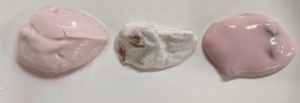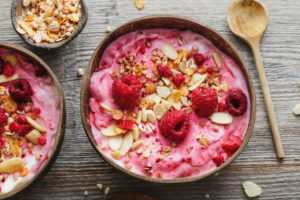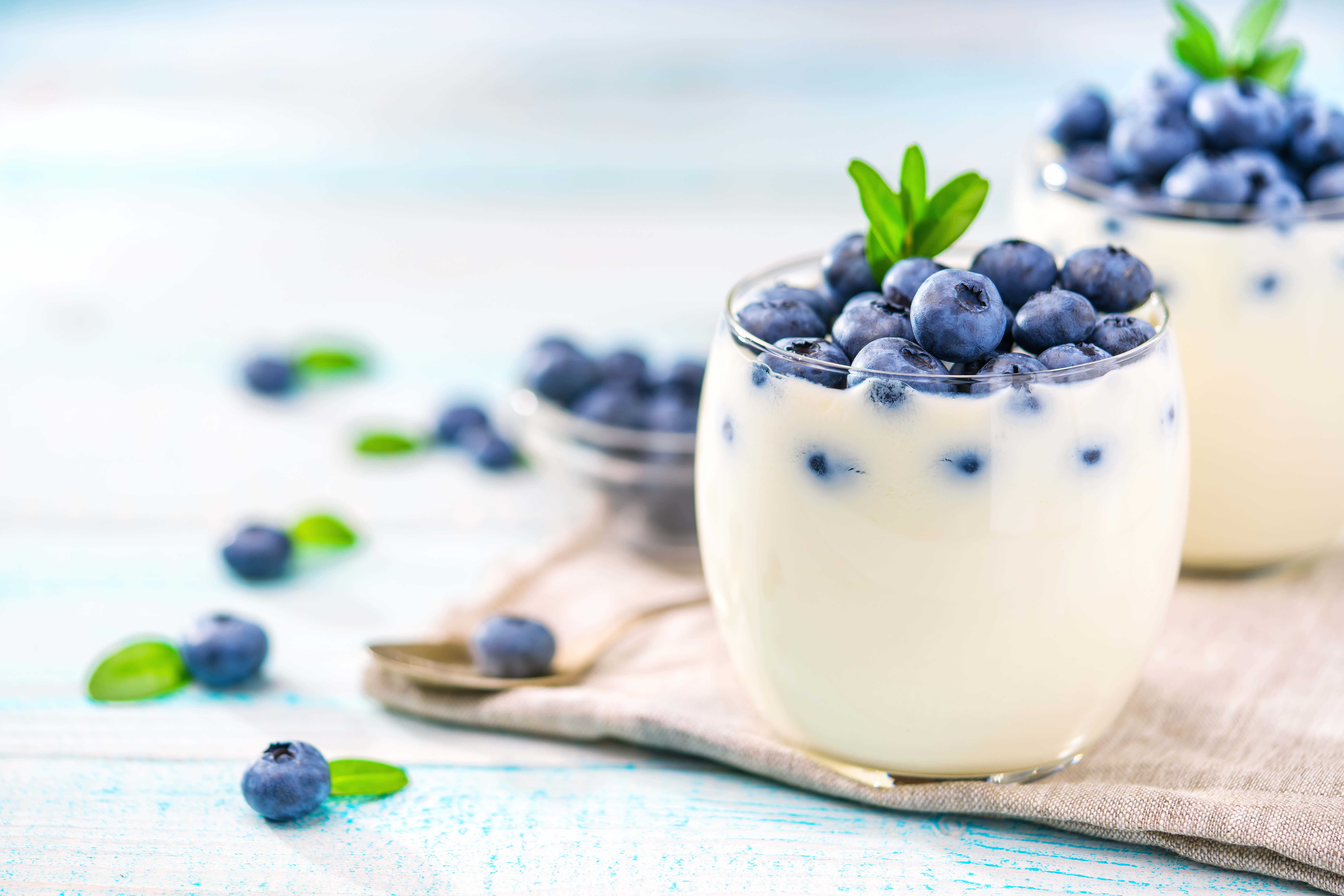Don’t just focus on flavor when building your product, but also keep in mind the textural component as it plays a critical role in the eating experience. Did you know that the texture of a product is not just its crunch, flow, or creaminess? While it typically is described in these terms, texture also impacts the visual appearance of a product, which is the first part of the eating experience, and sets the expectations of consumers. Texture also impacts the flavor release, changing the taste perception of the product without manipulating the flavor components. Texture is often an overlooked part of product development that can be adjusted to help drive product success. Let’s walk through the different elements of texture and how they play a role in one example: Yogurt.
Visual Texture:
 As you can see in these examples, the product on the left has semi-firm texture with surface grain and splitting causing significant amount of syneresis to come out on the plate. This sometimes can lead consumers to think the product may be old or spoiled when in fact syneresis is normal part of yogurt process. The middle sample you can see is lighter in color with a firm but gritty texture. There is also the visual texture of strawberries in the product which will tell the consumer to expect a fresh profile. The last sample has a more intense color intensity with a soft flowing visual appearance with a smooth texture. It also has visual strawberry pieces to help set the expectation with the consumer on a fresh flavor profile. Just looking at these products will instantly set the consumers’ expectation for their eating experience. Understanding your target consumer and what the texture will say to the consumer is important to keep in mind when developing any product.
As you can see in these examples, the product on the left has semi-firm texture with surface grain and splitting causing significant amount of syneresis to come out on the plate. This sometimes can lead consumers to think the product may be old or spoiled when in fact syneresis is normal part of yogurt process. The middle sample you can see is lighter in color with a firm but gritty texture. There is also the visual texture of strawberries in the product which will tell the consumer to expect a fresh profile. The last sample has a more intense color intensity with a soft flowing visual appearance with a smooth texture. It also has visual strawberry pieces to help set the expectation with the consumer on a fresh flavor profile. Just looking at these products will instantly set the consumers’ expectation for their eating experience. Understanding your target consumer and what the texture will say to the consumer is important to keep in mind when developing any product.
Texture:
Once a determination is made to consume the product, the next thing to typically hit the senses is the initial texture on the first bite. Is this product crunchy, soft, mushy, smooth, or creamy? Most food products have an expected texture that is common for that food product and consumers will expect that expectation to be met. In yogurts, most consumers are going to prefer a smooth, thick, and creamy product. If your product is in this realm, it can be differentiated by manipulating texture within the excepted range. If your product falls outside this by being gritty, grainy, or liquid, it can cause major issues for consumer as it falls outside the category expectations.
Flavor:
 Once the product is acceptable from a visual and texture standpoint, the flavor highlights the remaining eating experience. While the texture does not typically create the main flavor profile, it can impact it with secondary flavors or flavor release. When formulating a yogurt, a starch base can lead to a secondary flavor impact. If you go with a corn starch or rice starch, there is some minor inherent flavor that comes with these texturizers that can affect with main flavor profile. You can also use texture to help extend the flavor profile, as it does with acid or sweetness to prevent sharp peaks in the flavor profile. You also must keep in mind that some texturants can also mask flavors, which may or may not be a good thing. If the flavor profile is masked, the main flavor may need to be adjusted to compensate. In some cases, if you are trying to mask a bitterness or off flavor from another ingredient, the texturant could be your friend in optimizing your flavor profile.
Once the product is acceptable from a visual and texture standpoint, the flavor highlights the remaining eating experience. While the texture does not typically create the main flavor profile, it can impact it with secondary flavors or flavor release. When formulating a yogurt, a starch base can lead to a secondary flavor impact. If you go with a corn starch or rice starch, there is some minor inherent flavor that comes with these texturizers that can affect with main flavor profile. You can also use texture to help extend the flavor profile, as it does with acid or sweetness to prevent sharp peaks in the flavor profile. You also must keep in mind that some texturants can also mask flavors, which may or may not be a good thing. If the flavor profile is masked, the main flavor may need to be adjusted to compensate. In some cases, if you are trying to mask a bitterness or off flavor from another ingredient, the texturant could be your friend in optimizing your flavor profile.
This just is a little insight into how texture not only provides that crunch or creaminess to a product but can also impact multiple aspects of the eating experience. If you want to build off these concepts in your seasoning or have questions on the texture impact to your flavor, our team is here to help. Contact us today to see how we can help you make something special.
About the Author
 Dan Grazaitis joined the Fuchs team as the Director of R&D in 2019. He received his B.S. in Biology from Towson University before entering the work force in food science. He has extensive experience applying hydrocolloids in end use applications including dairy, bakery, dressings, sauces, beverages, confections, and non-food applications. Dan has shown success in taking innovative concepts from development to broad market launches in a wide variety of applications. His skillset includes hydrocolloids, proteins, sweeteners, rheology, applications development, innovation pipeline management, and product scale up.
Dan Grazaitis joined the Fuchs team as the Director of R&D in 2019. He received his B.S. in Biology from Towson University before entering the work force in food science. He has extensive experience applying hydrocolloids in end use applications including dairy, bakery, dressings, sauces, beverages, confections, and non-food applications. Dan has shown success in taking innovative concepts from development to broad market launches in a wide variety of applications. His skillset includes hydrocolloids, proteins, sweeteners, rheology, applications development, innovation pipeline management, and product scale up.


